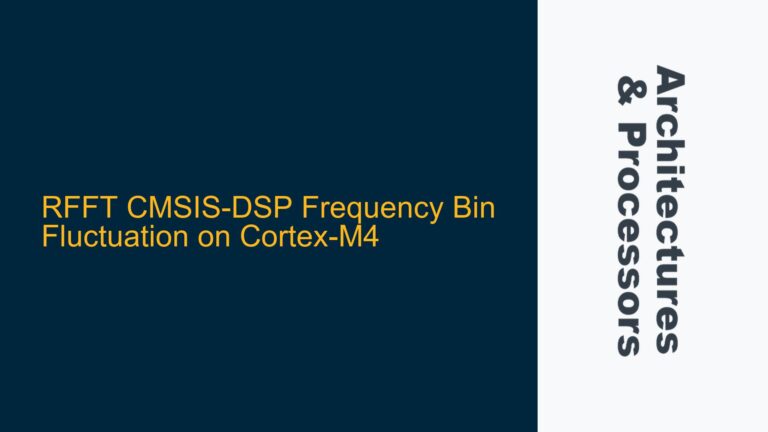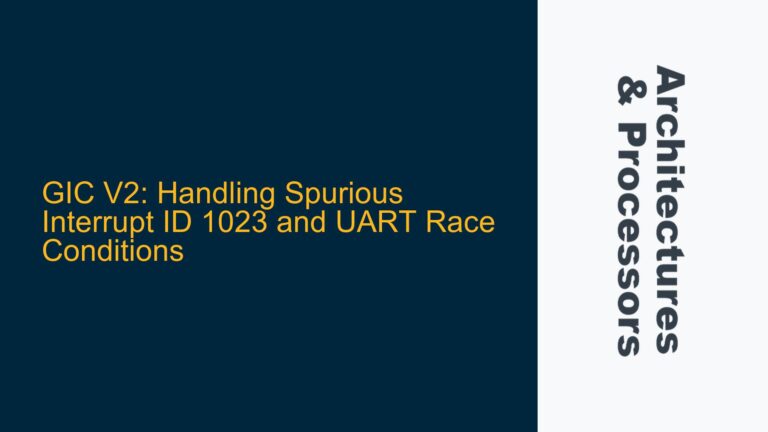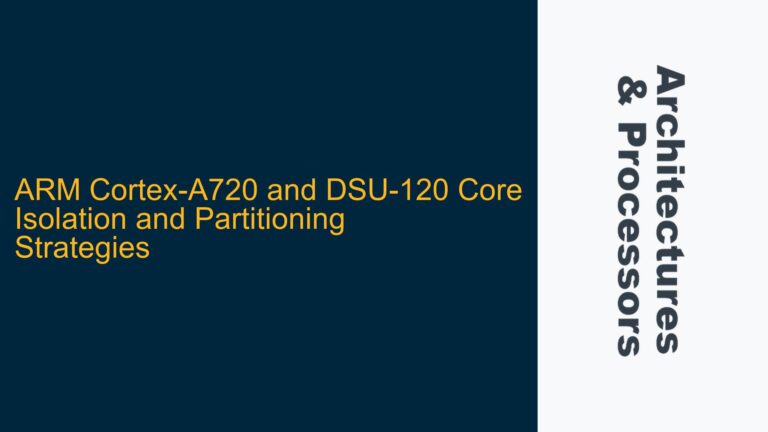Understanding TCM Interface Timing in ARM Cortex-R4F and TMS570LS3137
The Tightly Coupled Memory (TCM) interface in ARM Cortex-R4F processors is a critical component for achieving low-latency, high-performance memory access in real-time embedded systems. TCM is divided into two types: ATCM (Instruction TCM) and BTCM (Data TCM). These memory regions are directly connected to the processor core, enabling deterministic access times, which are essential for real-time applications. However, integrating TCM with specific System-on-Chip (SoC) implementations, such as the TMS570LS3137, can introduce challenges related to interface timing. This post delves into the intricacies of TCM interface timing, the potential causes of timing-related issues, and detailed troubleshooting steps to resolve them.
Missing or Inadequate Documentation on TCM Interface Timing
One of the primary challenges faced by developers working with the ARM Cortex-R4F and TMS570LS3137 is the lack of detailed documentation on TCM interface timing. While the ARM Cortex-R4 and Cortex-R4F Technical Reference Manual (TRM) provides a high-level overview of TCM functionality, it does not specify the exact timing requirements for the TCM interface. Similarly, the TMS570LS3137 datasheet and reference manuals do not provide sufficient details on how the TCM interface timing is implemented or configured within the SoC. This gap in documentation can lead to confusion and improper implementation, resulting in performance bottlenecks or system failures.
The TCM interface timing is influenced by several factors, including the clock frequency of the processor, the memory access latency, and the specific implementation of the TCM interface in the SoC. Without precise timing information, developers may struggle to optimize their firmware for deterministic performance. Additionally, the absence of timing details can make it difficult to diagnose issues related to memory access violations, data corruption, or unexpected behavior during high-speed data transfers.
To address this issue, developers must rely on a combination of available documentation, empirical testing, and consultation with the chip manufacturer. While the ARM TRM provides a foundation for understanding TCM functionality, the SoC-specific implementation details must be obtained from the chip manufacturer or derived through careful analysis of the hardware design.
Clock Domain Synchronization and Signal Integrity Issues
Another potential cause of TCM interface timing issues is improper synchronization between clock domains and signal integrity problems. The ARM Cortex-R4F processor and the TMS570LS3137 SoC may operate in different clock domains, especially if the TCM interface is connected to external memory or peripherals. If the clock domains are not properly synchronized, it can lead to metastability issues, where signals are sampled at incorrect times, causing data corruption or system crashes.
Signal integrity issues can also arise due to improper PCB layout, insufficient decoupling capacitors, or excessive trace lengths. These issues can manifest as glitches, ringing, or signal reflections, which can disrupt the timing of the TCM interface. For example, if the address or data lines of the TCM interface experience signal integrity problems, it can result in incorrect memory accesses or data corruption.
To mitigate these issues, developers must ensure that the clock domains are properly synchronized using techniques such as clock domain crossing (CDC) synchronization or phase-locked loops (PLLs). Additionally, signal integrity must be verified through careful PCB design, including proper trace routing, impedance matching, and the use of decoupling capacitors. Tools such as signal integrity simulators and oscilloscopes can be used to analyze and debug signal integrity issues.
Implementing Robust TCM Interface Timing Solutions
To resolve TCM interface timing issues, developers must adopt a systematic approach that includes both hardware and software optimizations. The following steps outline a comprehensive strategy for ensuring reliable TCM interface timing in ARM Cortex-R4F and TMS570LS3137-based systems.
Step 1: Review and Analyze Available Documentation
The first step in addressing TCM interface timing issues is to thoroughly review and analyze all available documentation, including the ARM Cortex-R4 and Cortex-R4F Technical Reference Manual, the TMS570LS3137 datasheet, and any application notes or reference designs provided by the chip manufacturer. While the documentation may not provide explicit timing details, it can offer valuable insights into the TCM interface’s operation and configuration.
Developers should pay close attention to sections of the documentation that describe the TCM interface’s clocking, memory mapping, and access protocols. Additionally, any information related to the SoC’s memory controller or bus architecture should be reviewed, as these components can influence the TCM interface’s timing.
Step 2: Consult with the Chip Manufacturer
If the available documentation does not provide sufficient details on TCM interface timing, developers should consult with the chip manufacturer for additional support. The manufacturer may have internal documentation or application notes that are not publicly available but can provide the necessary timing information. Additionally, the manufacturer’s support team can offer guidance on best practices for configuring and optimizing the TCM interface in the specific SoC.
When contacting the manufacturer, developers should provide detailed information about their system configuration, including the clock frequencies, memory layout, and any observed timing issues. This information can help the manufacturer provide more targeted support and recommendations.
Step 3: Perform Empirical Testing and Timing Analysis
In the absence of detailed timing information, developers must rely on empirical testing and timing analysis to characterize the TCM interface’s behavior. This process involves measuring the timing of critical signals, such as the address, data, and control lines, using an oscilloscope or logic analyzer.
Developers should create test cases that exercise the TCM interface under various conditions, including different clock frequencies, memory access patterns, and data transfer sizes. By analyzing the timing of these test cases, developers can identify any anomalies or deviations from expected behavior.
Additionally, developers can use simulation tools to model the TCM interface’s timing and identify potential issues before implementing the design in hardware. Tools such as SPICE or VHDL/Verilog simulators can be used to simulate the TCM interface’s behavior and validate the timing constraints.
Step 4: Optimize Firmware for Deterministic Performance
Once the TCM interface’s timing has been characterized, developers can optimize their firmware to ensure deterministic performance. This optimization process involves configuring the TCM interface’s clocking and memory access settings to minimize latency and maximize throughput.
Developers should also implement memory access patterns that align with the TCM interface’s timing constraints. For example, burst transfers or aligned memory accesses can reduce the overhead associated with address decoding and data transfer, improving overall performance.
Additionally, developers should consider using cache control instructions, such as data synchronization barriers (DSB) and instruction synchronization barriers (ISB), to ensure that memory accesses are properly synchronized with the TCM interface’s timing.
Step 5: Validate and Debug the System
The final step in resolving TCM interface timing issues is to validate and debug the system. This process involves running comprehensive tests to verify that the TCM interface operates correctly under all expected conditions.
Developers should use debugging tools, such as JTAG probes or in-circuit emulators, to monitor the TCM interface’s behavior and identify any timing-related issues. Additionally, developers can use performance profiling tools to measure the system’s performance and identify any bottlenecks or inefficiencies.
If timing issues are identified during validation, developers should revisit the previous steps to refine the TCM interface’s configuration and optimize the firmware. This iterative process may involve adjusting clock frequencies, modifying memory access patterns, or revising the PCB layout to improve signal integrity.
Conclusion
TCM interface timing is a critical aspect of ARM Cortex-R4F and TMS570LS3137-based systems, particularly in real-time embedded applications where deterministic performance is essential. While the lack of detailed documentation can pose challenges, developers can overcome these issues by combining available resources, empirical testing, and consultation with the chip manufacturer. By following a systematic approach to characterizing, optimizing, and validating the TCM interface’s timing, developers can ensure reliable and high-performance operation of their embedded systems.






